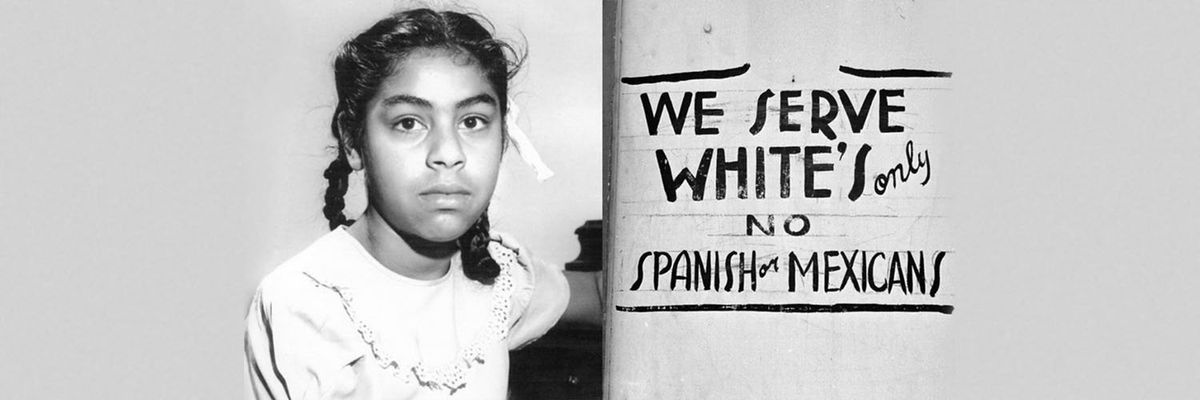Alpha Latinas
In The Community
This article is part of a series developed in partnership with Project Pulso.
When the tale of American civil rights unfolds, towering giants like Rosa Parks and Martin Luther King Jr. often take center stage. While their stories are indeed awe-inspiring and rightfully belong center-stage, it's also vital to highlight the untold tales of heroism within the Latine community, and one such unsung heroine is Sylvia Mendez, whose journey paved the way for dismantling school segregation long before the renowned Brown v. Board of Education case.
On a sunny day on June 7, 1936, in Santa Ana, California, Sylvia Mendez, daughter of Puerto Rican and Mexican immigrants, opened her eyes to the world. Her parents, Gonzalo and Felicitas Mendez, were hardworking farmers, leasing their land from a Japanese-American family interned during World War II.
Aged only 8, Sylvia and her siblings encountered the bitter taste of racial discrimination in 1944. They were turned away from the local 'whites only' 17th Street Elementary School due to their Mexican-Puerto Rican lineage. Instead, they were directed towards the run-down, barely functional Hoover Elementary School, a makeshift “school” for Mexican American students.
Witnessing this stark discrimination enraged Sylvia’s parents. Determined to fight back, they launched a legal battle against the Westminster School District of Orange County in 1945. Alongside four other Mexican-American families, the Mendez's spearheaded a class-action lawsuit, which symbolized the fight for 5,000 children in Orange County.
Their argument hinged on the violation of the 14th Amendment of the Constitution - equal protection under the law. Despite an initial setback at the local district court, they pressed on, taking the case to the Ninth Circuit Court of Appeals. After a long-drawn-out struggle, victory arrived in 1947, when the Court ruled in favor of the Mendez family, marking the first judicial verdict against school segregation in the United States.
This historic ruling set the stage for Brown v. Board of Education, the celebrated Supreme Court case that declared racial segregation in public schools unconstitutional seven years later in 1954.
Following this groundbreaking decision, Sylvia Mendez courageously stepped into uncharted territory as the first Latina student in an all-white school. Despite the landmark ruling, she faced a storm of hostility and prejudice from her classmates and teachers. Isolation, taunts, and name-calling became her daily companions.
Yet, Sylvia stood her ground, proving her worth and reinforcing her right to belong. As an adult, she pursued nursing, earning a degree from the prestigious University of California, Los Angeles (UCLA). She went on to serve as a dedicated nurse at the Los Angeles University of Southern California Medical Center for 30 years.
While Sylvia Mendez may not be a household name like other civil rights activists, her profound impact on American education is undeniable. In her later years, she passionately campaigned to spread awareness about her family's pivotal role in ending school segregation and fostering educational equality.
In 2011, her lifelong dedication to equality and civil rights earned her the Presidential Medal of Freedom from President Barack Obama, the highest civilian honor in the United States. Her inspiring journey has been immortalized in the award-winning children's book, "Separate Is Never Equal: Sylvia Mendez and Her Family's Fight for Desegregation" by Duncan Tonatiuh.
Sylvia Mendez's story is a beacon of perseverance, courage, and the relentless pursuit of equality. Her path-breaking entry into an all-white school symbolizes the ongoing struggle for educational equity and civil rights. Mendez v. Westminster not only altered her life but also laid the groundwork for ending racial segregation in schools nationwide. Sylvia Mendez is indeed a trailblazer who personifies the spirit of resistance against racial discrimination, carving out her deserving place in the pages of American civil rights history.
- The Lost History of the Adelitas of the Mexican Revolution ›
- Las Patronas de La Bestia: A Brief History ›
This article is part of a series developed in partnership with Project Pulso.
Sor Juana Inés de la Cruz is a towering figure in the literary canon of the Spanish-speaking world. Born in the mid-17th century, in colonial-era Mexico, she was a woman far ahead of her time, breaking barriers in areas like education, women's rights, and even expressions of sexuality. Today, her legacy is an inspiration for women, educators, and the queer community around the globe.
A Self-taught Scholar
Born in 1648, Juana Ramírez de Asbaje, later known as Sor Juana Inés de la Cruz after becoming a nun, was a child prodigy who taught herself to read and write. She developed a deep love for learning, despite women's education being frowned upon in her era. Sor Juana's craving for knowledge was insatiable; she allegedly begged her mother to allow her to disguise herself as a boy to attend the university, which was closed to women.
Her self-acquired education led her to become one of the most educated women of her time, a scholar of wide-ranging topics, including theology, philosophy, music, and natural science. In her convent enclosure, she compiled a vast library, making it a sanctuary of learning that defied the restrictive norms of the time.
Advocate for Women's Rights
Sor Juana was unyielding in her fight for women's rights, especially the right to education. Her most famous work, "Respuesta a Sor Filotea" (Reply to Sister Philotea), is a passionate defense of women's right to knowledge and education. She argued that women had the same natural rights as men to knowledge and learning, an idea that was revolutionary at the time.
In her writings, Sor Juana exposed the hypocrisy of the patriarchal society that chastised women for wanting to educate themselves while simultaneously blaming them for not being knowledgeable. Through her intellectual achievements and passionate advocacy, she became a trailblazer for women's rights and a pioneer of early feminist thought.
Queer Expression in Her Poetry
Sor Juana's poetry is not only celebrated for its lyrical brilliance and intellectual depth but also for its exploration of feminine sexuality. Many of her poems present strong homoerotic subtexts, offering a fresh perspective on female sexuality that contrasted starkly with the dominant narratives of her era.
While the term 'lesbian' did not exist in the 17th century, her love poetry often includes female muses and objects of desire. Poems like "Rosa Divina Que En Gentil Cultura," with its sensuous imagery and feminine symbols, later led critics and scholars to interpret them as expressions of queer identity.Divine rose, that in a gentle upbringing,
with your fragrant subtlety, are
the purple-tinted teacher of splendor,
and a snowy lesson for beauty.
Gesture of human architecture,
an example of vain kindness,
in which Nature decided to join
a joyful cradle and a sorrowful grave.
How arrogant you're in your splendor,
as you disdain the risk of dying,
and then, withered and hunched,
you give gloomy signs of your expiration,
with it, a well versed death, and foolish life,
you deceive by living and teach by dying!
The lesbian interpretation of her poetry remains contentious due to the historical and cultural distance. However, there's no denying that her vivid explorations of female love and desire are highly unusual for her time and she challenged traditional 17th-century norms. Whether Sor Juana identified as a lesbian or not, her verses resonate with many people in the LGBTQ+ community and have made her an important figure in queer literature.
A Lasting Legacy
Sor Juana Inés de la Cruz left behind a legacy that resonates with people worldwide. She broke barriers at a time when women were actively discouraged from seeking education and knowledge. Her brave advocacy for women's rights marked her as a precursor of feminist thought. Moreover, her provocative poetry challenged the dominant heteronormative narratives of the time, making her a significant figure in queer literary studies.
To this day, she’s a powerful symbol of resistance against the subjugation of women and the denial of their rights to education and the expression of their sexuality. Her life and work continue to inspire and empower women, educators, and members of the LGBTQ+ community around the world, affirming that knowledge, courage, and authenticity are boundless, regardless of time and place.
- The History of Hoop Earrings: Uniting Latinas Across Generations ›
- The Lost History of the Adelitas of the Mexican Revolution ›
National Latina Day is a day of celebration and recognition dedicated to honoring the contributions and achievements of Latinas in U.S. society, from arts and culture to politics and business. On this day, the rich cultural heritage, resilience, and trailblazing spirit of Latina women are brought to the forefront, and communities unite to pay homage to their legacy. But who is the woman behind this movement? And why is she left in the shadows?
How did National Latina Day Start?
The roots of National Latina Day can be traced back to 2015 when Texas-based Dolores “Loli” Alvarez Castilla created a Facebook page to empower Latinas. Over time, as the Latina community expanded its influence in the U.S. and around the world, it became evident that there was a pressing need to have a day dedicated to the celebration and amplification of the myriad of achievements and stories of Latina women.
In an interview with blogger April Monterrosa, Castilla said her message about the day is simple, “It is time for us to stand up and be counted for all that we are and all of our accomplishments. It is time to change the mindset of people that we are just loud women with attitudes.”
As the designated day made the rounds, Latinas everywhere began to share their experiences, achievements, and pride as Latinas. National Latina Day was born, and it’s been celebrated every year on August 20 since then, with red as the official color of the day.
Why Celebrate Latina Day?
In an era where Latinas frequently grapple with cultural stereotypes, National Latina Day serves as a powerful counter-narrative. Instead of subscribing to broad-brushed notions, this day thrusts the spotlight on individual stories that epitomize grit, intelligence, and resilience, effectively shattering age-old stereotypes.
This celebration paves the way for the future. The young Latina generation, looking ahead, now finds itself surrounded by a diverse range of role models. Be it the groundbreaking work of scientists or the mesmerizing creations of artists, the horizons have expanded, allowing these young minds to dream beyond traditional confines and outdated cultural expectations.
At its heart, National Latina Day is also a celebration of culture. Latinas stand as the proud bearers of an intricate cultural tapestry. From the rhythmic cadences of the Caribbean to the deeply-rooted traditions of South America, they play a pivotal role in enriching the American and global cultural landscape.
Lastly, this day is synonymous with unity. It's an amalgamation of shared narratives, mutual respect, and a collective sense of pride. Latinas and the broader community converge in a spirited celebration, fostering an environment of community and collaboration.
Honor the Past and Celebrate the Future
National Latina Day is more than just a day; it's a movement. A movement that seeks to recognize the past, celebrate the present, and inspire the future. It’s a testament to the strength, beauty, and indomitable spirit of Latina women.
It’s with this in mind that we also note that celebrating each other also means lifting up those who paved the way and giving them their flowers and due credit. Latinas have too few well-known leaders and role models, and the historical erasure of Latina contributions is well documented. It continues to be up to us to ensure that those who paved the way know that their contributions won’t be forgotten.
Celebrate this day and the woman who started it all, and honor the stories not just of the countless Latinas who have paved the way, but also of the Latinas who are shaping our present today and undoubtedly creating a brighter future for tomorrow.




